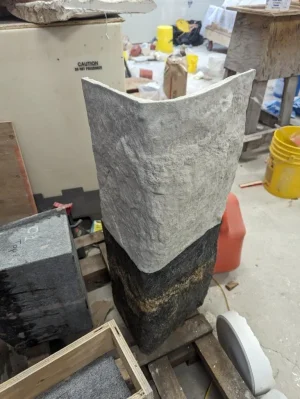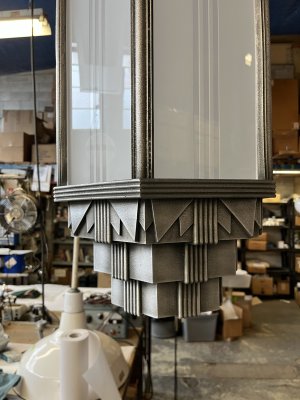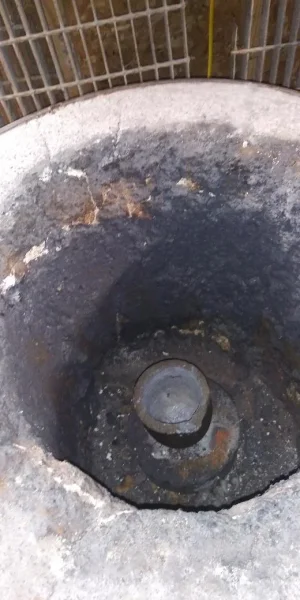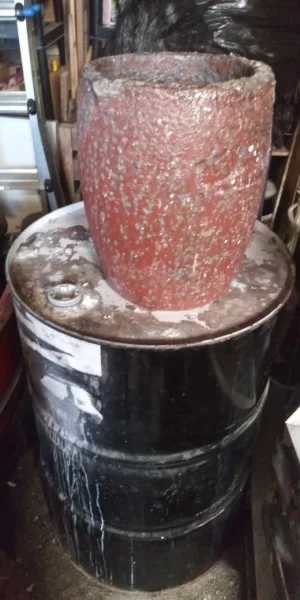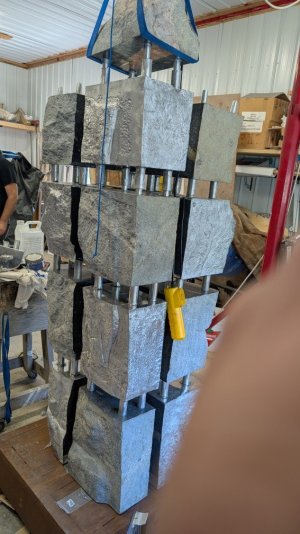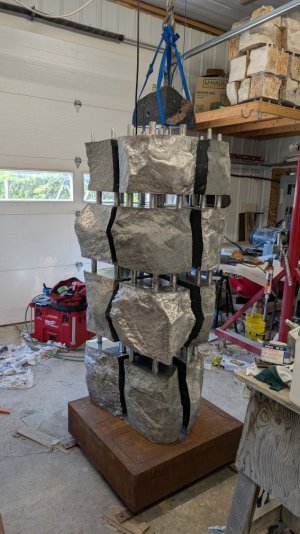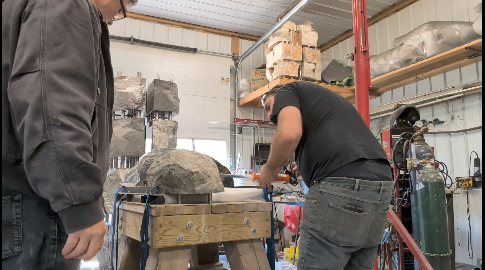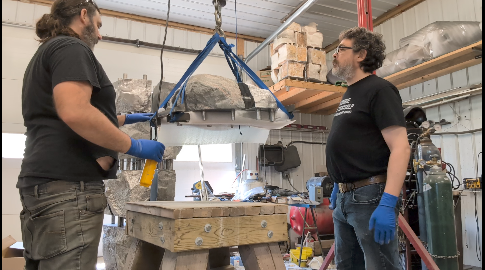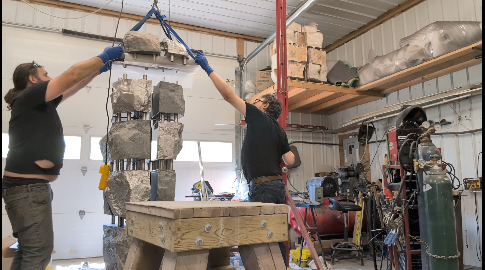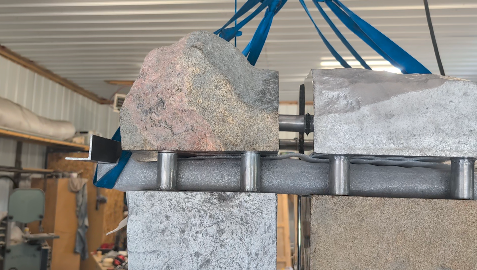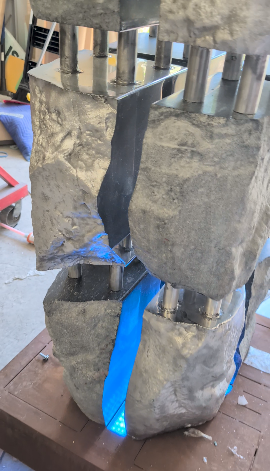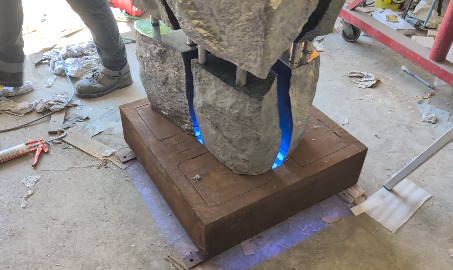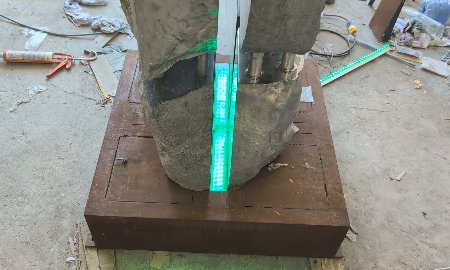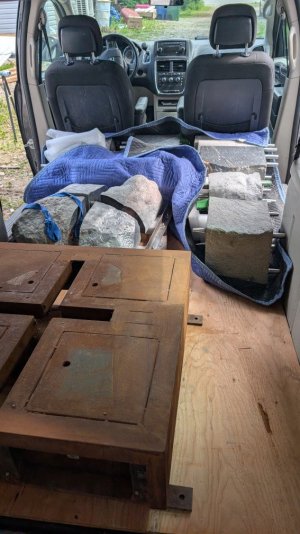Tobho Mott
Well-Known Member
Been working with local artist David Perrett on his latest sculpture, specifically I'm helping him out with a lot of the foundry work involved. He's got his own foundry newly set up after moving to the national capital region from Hamilton about a year ago, so I've been driving out to his place since my own foundry only has space for one to work comfortably. And it's definitely a 2 man job to move these big molds around. (Most have been done in 18" x 18" ID flasks with a cope made of 2x4's and a drag made of 2x6's. That's a couple hundred pounds easy for each mold) Plus that's where all the patterns are. And it's his project. I've got 5 full days of molding and pouring into his project so far, and he's also made and poured several of the molds without me by dragging in his wife and neighbours to hold one end of the pouring shank. He did enough casting in art school to know the basics, really he only needs me as a consultant on the dark art of mold gating and a confident hand at ramming sand. So much sand.
He tells me I'll be missing the last pour (fingers crossed) tonight. Makes me a little sad. Pretty sure he'll nail it though, so far we've only poured one part we had to scrap (not one I rammed up, I'll point out ) - the cope (top mold half) cracked a little somehow and dropped some loose sand onto the drag, so the casting had some nasty inclusions in it. Win some lose some.
) - the cope (top mold half) cracked a little somehow and dropped some loose sand onto the drag, so the casting had some nasty inclusions in it. Win some lose some.
It's a pretty wild project. Who can hope to understand how an artist's mind works?? The subject is this tall skinny boulder.

He cut it into 5 rows then cut each row into quarters. So that's 20 pieces. Half of them are to be removed and replaced with cast aluminum copies, in a sort of checkerboard pattern. And with a little space between each block.
Eventually there'll be a second boulder, identical but oppositely checkerboarded, made with aluminum copies of the remaining 10 stone blocks and the stone blocks that were removed and replaced with metal in the first piece (phew!).
But for now we're focused just getting the first set of 10 cast aluminum stone blocks done so he can assemble and finish boulder #1 and get it to the gallery.
He made rubber molds of just the uncut faces of each block, backed with plaster mother molds. Then he cast a thin (1cm to maybe 1", it's hard to be more precise when smearing plaster around) burlap-reinforced plaster copy of each of those uncut faces.

With wooden pull-screw points embedded into the back side.

This particular pattern as shown would absolutely not pull clean from a sand mold because of the undercut 2/3 of the way to the right side of the following pic.

It will have to be band sawed in two along the central ridge, then David will have to weld the two resulting castings together and chase the seam. Many but not all of the patterns have had to be cut like that; obviously the less welding and chasing David has to do, the better, but an undercut is an undercut.


The cast blocks will be hollow of course. The cut stone faces will be replicated with aluminum plate, more chasing, and welding A356 to itself and to the plate metal (6061? Not sure) won't be fun. Mercifully, not my job but David isn't too bad with a TIG machine
Here is an idea of what it's going to look like, but obviously this is only 3/5 of 1/4 of the whole sculpture. The welding and chasing isn't complete and the spacers will be shorter in the end.


More pics to come
Jeff
He tells me I'll be missing the last pour (fingers crossed) tonight. Makes me a little sad. Pretty sure he'll nail it though, so far we've only poured one part we had to scrap (not one I rammed up, I'll point out
It's a pretty wild project. Who can hope to understand how an artist's mind works?? The subject is this tall skinny boulder.
He cut it into 5 rows then cut each row into quarters. So that's 20 pieces. Half of them are to be removed and replaced with cast aluminum copies, in a sort of checkerboard pattern. And with a little space between each block.
Eventually there'll be a second boulder, identical but oppositely checkerboarded, made with aluminum copies of the remaining 10 stone blocks and the stone blocks that were removed and replaced with metal in the first piece (phew!).
But for now we're focused just getting the first set of 10 cast aluminum stone blocks done so he can assemble and finish boulder #1 and get it to the gallery.
He made rubber molds of just the uncut faces of each block, backed with plaster mother molds. Then he cast a thin (1cm to maybe 1", it's hard to be more precise when smearing plaster around) burlap-reinforced plaster copy of each of those uncut faces.
With wooden pull-screw points embedded into the back side.
This particular pattern as shown would absolutely not pull clean from a sand mold because of the undercut 2/3 of the way to the right side of the following pic.
It will have to be band sawed in two along the central ridge, then David will have to weld the two resulting castings together and chase the seam. Many but not all of the patterns have had to be cut like that; obviously the less welding and chasing David has to do, the better, but an undercut is an undercut.
The cast blocks will be hollow of course. The cut stone faces will be replicated with aluminum plate, more chasing, and welding A356 to itself and to the plate metal (6061? Not sure) won't be fun. Mercifully, not my job but David isn't too bad with a TIG machine
Here is an idea of what it's going to look like, but obviously this is only 3/5 of 1/4 of the whole sculpture. The welding and chasing isn't complete and the spacers will be shorter in the end.
More pics to come
Jeff

